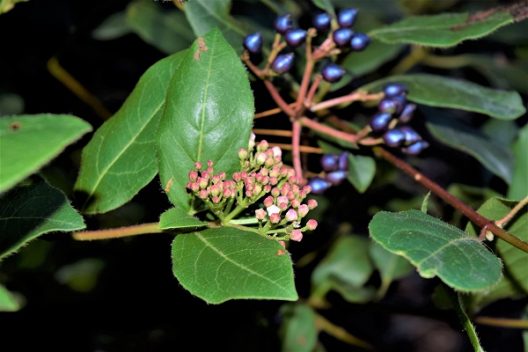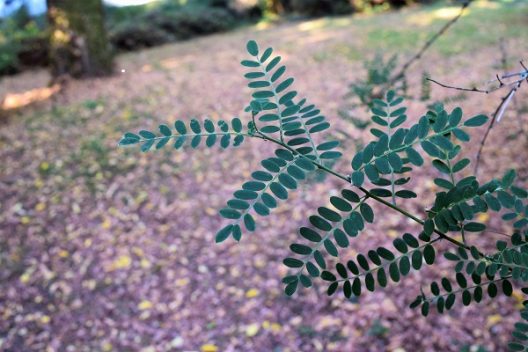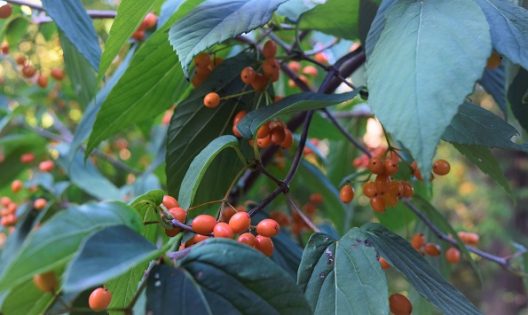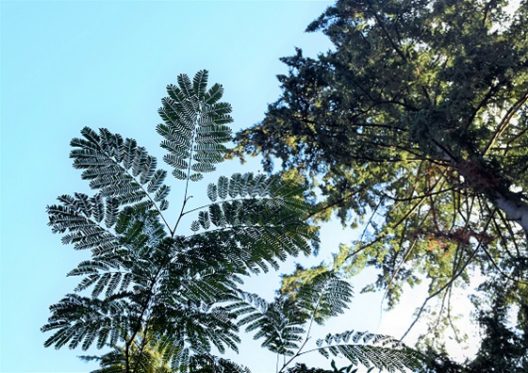With the drought still hanging around, these drought-tolerant species are not ready to drop their foliage and are standing tall.
1) Viburnum tinus ‘Purpureum’
- Native to the Mediterranean region.
- With blue/purple berries and white/pink flowers and purple foliage, this is a beautiful shrub for interest in October. Great resource for pollinators.
- Many found along the Arboretum Loop Trail (A.L.T) on the west side in the Viburnum Collection.
|
 Viburnum tinus ‘Purpureum’ Viburnum tinus ‘Purpureum’
|
2) Sophora davidii David’s Mountain Laurel
- Previously known as Sophora viciifolia.
- The roots are used traditionally as a medicinal herb in China to help a sore throat and inflammation.(1)
- Be sure to check out its beautiful flowers in the spring.
- Late dropping of leaves. Once they do, they turn yellow, adding a nice pacing of fall color.
- Find these in the Legumes section, in the beds near the benches.
|
 Sophora davidii Sophora davidii
|
3) Aralia californica Elk Clover
- White flowers in late summer, turning to a red, then blue/purple berry.
- Commonly used medicinally to relieve a cough, inflammation, and induce menstruation postponed by stress and other factors.(2)
- The Pomo, Yuki, and Concow Nations used this as a highly valued herb. (2)
- Find these in the Cascadia section of the Pacific Connections Garden at the top of the hill.
|
 Aralia californica Aralia californica
|
4) Viburnum setigerum Tea Viburnum
- The berries start out orange and turn a bright red as they age, and they cause a weeping effect with their prolific production.
- In the Sichuan Province, monks on Emei (pronounced “Omei”) Mountain used the leaves for medicinal sweet tea.(3)
- Many found along the A.L.T on the west side in the Viburnum Collection.
|
 Viburnum setigerum Viburnum setigerum
|
5) Albizia kalkora Kalkora Mimosa
- Has naturalized along the southeastern coast of the U.S. and has even hybridized with the Albizia julibrissin or Silk Tree in the region.
- Yellowish-white bloom from May to June, but during this time of the year, it has a nice bright yellowish fall color.
- Native to eastern Asia.
- Found on the west side of the A.L.T. just south of the Birch lot or Parking Lot 19.
- Even pinnately compound leaf structure or bi-pinnate. They close as the sun sets and open with sunrise.
|
 Albizia kalkora Albizia kalkora
|
References:
(1) https://pubmed.ncbi.nlm.nih.gov/35342795/ [pubmed.ncbi.nlm.nih.gov]
(2) “Plants used by the Indians of Mendocino County, California” by Victor King Chesnut; pg. 371 see – Aralia californica
(3) https://landscapeplants.oregonstate.edu/plants/viburnum-setigerum [landscapeplants.oregonstate.edu]




